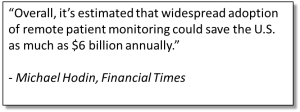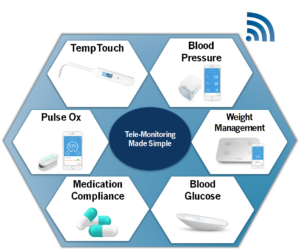The Center for Medicare and Medicaid Services (CMS), and the American Medical Association (AMA), have jointly recognized a rapid increase in Medicare and Medicaid services, which totaled nearly $3.65 trillion in 2018. With the aging Medicare population a significant portion of these costs are attributable to chronic conditions like diabetes, hypertension, hyperlipidemia, asthma, and many others. With real-time, at-home monitoring, these diseases can be proactively managed to prevent catastrophic outcomes like heart attack or stroke. Accordingly, In November of 2018, CMS announced the creation of three new reimbursement codes grouped in a previously unaddressed category called Remote Patient Monitoring (RPM). These codes became effective on January 1, 2019.
costs are attributable to chronic conditions like diabetes, hypertension, hyperlipidemia, asthma, and many others. With real-time, at-home monitoring, these diseases can be proactively managed to prevent catastrophic outcomes like heart attack or stroke. Accordingly, In November of 2018, CMS announced the creation of three new reimbursement codes grouped in a previously unaddressed category called Remote Patient Monitoring (RPM). These codes became effective on January 1, 2019.
The global RPM market is expected to reach $41.7 billion by 2028. For example, there are approximately 50 million adults over the age of 65 in the US, 44 million of whom are enrolled in Medicare. Of these, 58 percent have hypertension which means 25.5 million would qualify for remote blood pressure monitoring under Medicare.
MR3, with its capability to Monitor, Report, Respond and Remediate and adaptable platforms can provide assistance to physicians offering RPM services to their chronically ill patients using multiple physiologic monitoring devices (i.e. blood pressure management, blood glucose monitors, pulse oximeters, smart weight scales and others), MR3 monitors patients on a daily basis, identifying those with negative physiologic trends. Upon identification, alerts are communicated to the member, healthcare payer, and member’s clinical team indicating high risk of an acute health event. MR3 proactively identifies the need for intervention thereby providing the opportunity to reduce risk and the potential cost of treatment and hospitalization.This produces a number of positive results for all parties, including:
- Better outcomes and reduced acute care episodes for patients with chronic conditions.
- Lower healthcare costs for insurers, health plans and hospitals.
- Increased revenue streams for physicians.
Whether your practice is large or small, we invite you to contact us to learn more about MR3’s approach and unique service can help achieve these outcomes, and how we can help you streamline and automate remote patient monitoring and chronic care management while successfully reducing acute episodes of chronic health conditions.MR3 will either charge the healthcare payer a per-member/per-month fee to access the MR3 service and support network or will charge the provider to assist with billing the correct CPT codes for the service. Either way, MR3 will provide the devices to monitor the patient’s physiologic parameters, daily monitoring services, a robust support team, customer service access and a rapid response alert to the member’s clinical care team.


